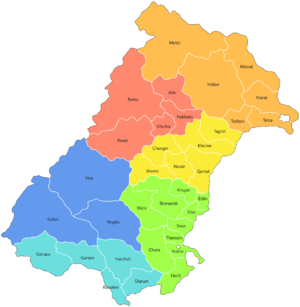Difference between revisions of "Prefectures of Lugida"
(head section) |
|||
| Line 19: | Line 19: | ||
}} | }} | ||
The '''Prefectures of Lugida''' ({{small|[[Lithian]]:}} ''Sefir''), sometimes known informally or in historical contexts as the '''domains of Lugida''', consist of 47 prefectures which form the first-level administrative divisions of [[Lugida]]. Of these, 41 are proper prefectures, three are special prefectures ([[Gerupa Prefecture|Gerupa]], [[Lenthir Prefecture|Lenthir]], and [[Melon Prefecture|Melon]]), two are urban prefectures ([[Hara Prefecture|Hara]] and [[Tom Prefecture|Tom]]), and one is a capital prefecture ([[Natlia]]). The system was established in 1869 by the then-newly established administration of the Republic of Lugida to replace the former [[Kingdom of Melunair]]'s system of circuits and its subdivision domains, hence the term 'domain' for prefectures. | The '''Prefectures of Lugida''' ({{small|[[Lithian]]:}} ''Sefir''), sometimes known informally or in historical contexts as the '''domains of Lugida''', consist of 47 prefectures which form the first-level administrative divisions of [[Lugida]]. Of these, 41 are proper prefectures, three are special prefectures ([[Gerupa Prefecture|Gerupa]], [[Lenthir Prefecture|Lenthir]], and [[Melon Prefecture|Melon]]), two are urban prefectures ([[Hara Prefecture|Hara]] and [[Tom Prefecture|Tom]]), and one is a capital prefecture ([[Natlia]]). The system was established in 1869 by the then-newly established administration of the Republic of Lugida to replace the former [[Kingdom of Melunair]]'s system of circuits and its subdivision domains, hence the term 'domain' for prefectures. | ||
Prefectures are divided into municipalities including cities, towns, and in Natlia, capital wards. Governors and prefectural parliaments are elected in five-year terms. They have administrative, executive, and legislative authority within their prefectures' boundaries in respect to the central government of Lugida; the central government reserves the right to prevent a prefecture law from being enacted especially if the law contradicts higher-level laws such as a Ministerial Order, the National Code, and the [[Constitution of Lugida|Constitution]]. Special prefectures have greater autonomy. For example, they can enact prefectural laws that override higher-level laws except the Constitution and can designate an official regional language. | |||
==Background== | ==Background== | ||
| Line 33: | Line 35: | ||
===Capital=== | ===Capital=== | ||
==List of | ==List of prefectures== | ||
==See also== | ==See also== | ||
Revision as of 12:07, 8 December 2017
| Prefecture Sefir | |
|---|---|
 | |
| Category | Unitary state |
| Location | Lugida |
| Number | 47 prefectures – 41 proper prefectures – 3 special prefectures – 2 urban prefectures – 1 capital prefecture |
| Populations | 616,194 (Sharjai) – 16,813,021 (Natlia) |
| Government | Governor Prefectural Parliament |
| Subdivisions | Municipality Capital ward (Natlia) |
The Prefectures of Lugida (Lithian: Sefir), sometimes known informally or in historical contexts as the domains of Lugida, consist of 47 prefectures which form the first-level administrative divisions of Lugida. Of these, 41 are proper prefectures, three are special prefectures (Gerupa, Lenthir, and Melon), two are urban prefectures (Hara and Tom), and one is a capital prefecture (Natlia). The system was established in 1869 by the then-newly established administration of the Republic of Lugida to replace the former Kingdom of Melunair's system of circuits and its subdivision domains, hence the term 'domain' for prefectures.
Prefectures are divided into municipalities including cities, towns, and in Natlia, capital wards. Governors and prefectural parliaments are elected in five-year terms. They have administrative, executive, and legislative authority within their prefectures' boundaries in respect to the central government of Lugida; the central government reserves the right to prevent a prefecture law from being enacted especially if the law contradicts higher-level laws such as a Ministerial Order, the National Code, and the Constitution. Special prefectures have greater autonomy. For example, they can enact prefectural laws that override higher-level laws except the Constitution and can designate an official regional language.